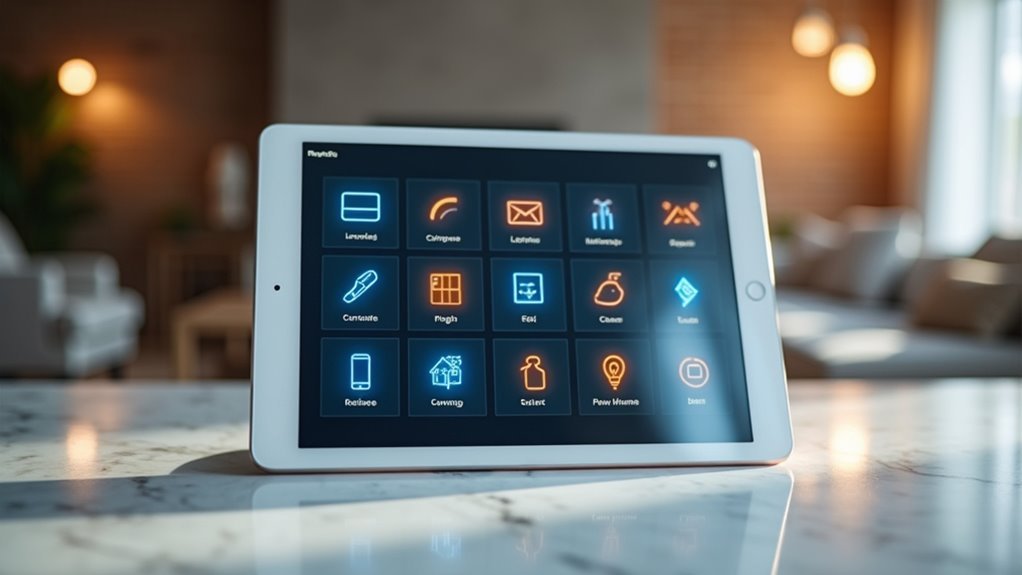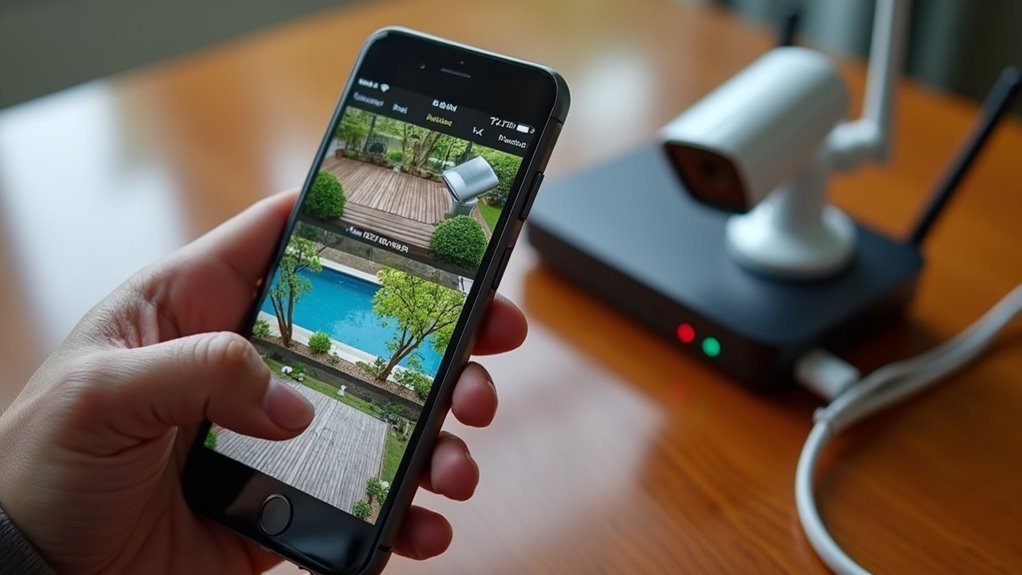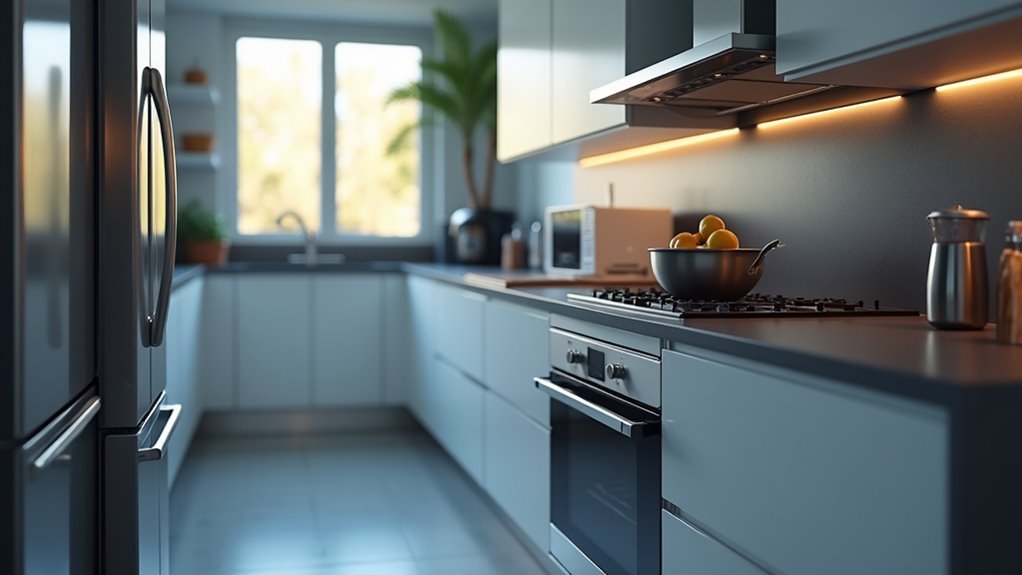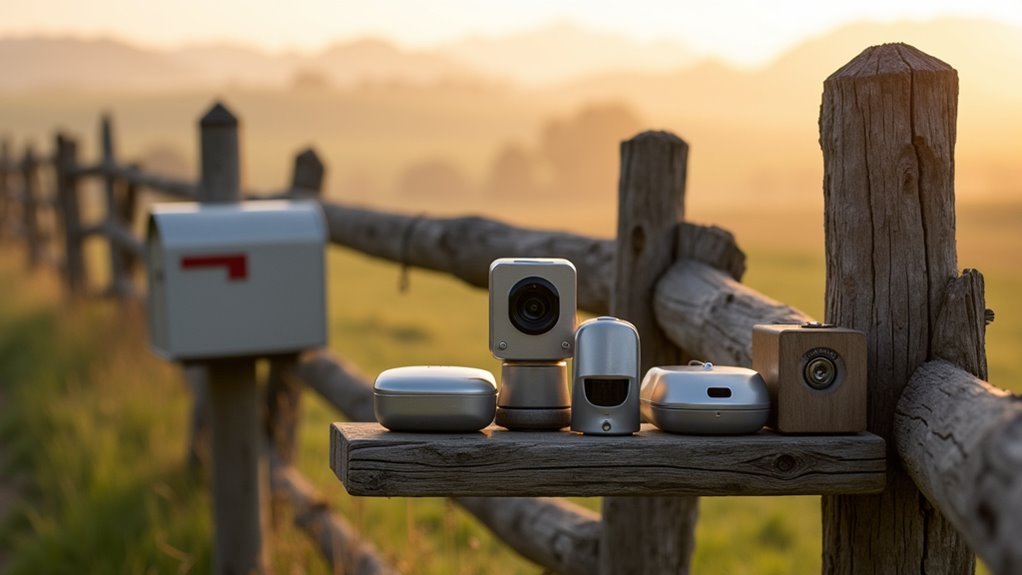You’re tired of struggling with clunky home automation interfaces that don’t match your workflow or aesthetic preferences. Your current dashboard probably forces you into a rigid layout that makes simple tasks unnecessarily complicated. What if you could transform that frustrating experience into something that actually works the way you think? The solution lies in understanding how modern customization tools can reshape your entire approach to home control, but there’s a specific method that most people overlook.
Drag-and-Drop Interface for Seamless Dashboard Design

Simplicity defines the core of modern dashboard design, and the drag-and-drop interface delivers exactly that. You’ll find arranging your smart home devices becomes effortless as you simply click and move tiles wherever you want them.
This intuitive system lets you create personalized dashboards that match your specific needs and preferences. You can customize each tile’s icons, labels, colors, and styles to reflect your aesthetic vision.
Whether you’re using a tablet in landscape mode or checking device status on your phone in portrait orientation, the interface adapts seamlessly to any screen size.
The responsive design ensures your dashboard looks perfect and functions flawlessly across every device you own.
Even without technical expertise, you’ll quickly master creating sub-dashboards for specific functions like lighting or security. The user-friendly approach guarantees accessibility while maintaining powerful customization capabilities.
Real-Time Device Monitoring and Status Updates
You’ll see your device statuses update instantly on your home control dashboard, giving you immediate visibility into whether doors are locked, lights are on, or systems are running properly.
Your dashboard refreshes automatically as conditions change throughout your home, so you’re always working with current information. This live monitoring means you can quickly spot issues like security breaches or device malfunctions without manually checking each system.
Instant Device Status Display
When you need to monitor your smart home devices, the instant device status display delivers real-time information at your fingertips.
You’ll see exactly what’s happening throughout your home through color-coded indicators that highlight critical statuses requiring immediate attention. This thorough view covers a wide range of connected devices, from locked doors to thermostat settings.
The instant status display transforms how you manage your home:
- Peace of mind – You’ll never wonder if you locked the front door again
- Complete control – Every device status is visible in one centralized location
- Immediate action – Critical alerts prompt instant responses to protect your family
Your customizable tiles arrange according to your preferences, while the responsive design guarantees access from anywhere.
Review our Privacy Policy for data handling details.
Live Dashboard Updates
As your smart home evolves throughout the day, live dashboard updates guarantee you’re always connected to what’s happening in real-time. You’ll receive instant notifications when door locks engage, lights switch on, or thermostats adjust automatically. The dashboard refreshes continuously, ensuring you never miss critical changes.
| Update Type | Refresh Rate | Device Coverage |
|---|---|---|
| Security Status | Instant | Door locks, cameras, alarms |
| Climate Control | 30 seconds | Thermostats, sensors, fans |
| Lighting Systems | Real-time | Smart bulbs, switches, dimmers |
| Weather Data | 15 minutes | Forecasts, temperature, alerts |
| Energy Monitoring | 5 minutes | Usage meters, solar panels |
Your customizable tiles adapt to any screen size, delivering clear updates whether you’re using your phone, tablet, or wall-mounted display. Quick automation access lets you respond immediately to changing conditions.
Essential Tile Integration for Weather and Calendar Data

Since staying informed about weather conditions and upcoming appointments directly impacts your daily decisions, integrating weather and calendar tiles into your home control dashboard becomes a game-changing feature.
You’ll have live weather feeds displaying current conditions and forecasts at your fingertips, eliminating the need to check multiple apps.
Your customizable calendar tiles seamlessly manage schedules from different sources while keeping you organized.
Here’s what makes these integrations essential:
- Never miss important events – Real-time calendar updates guarantee you’re always prepared for meetings and appointments.
- Plan your day confidently – Instant weather data helps you dress appropriately and schedule outdoor activities.
- Stay effortlessly organized – Multiple calendar integration keeps your personal and professional life synchronized.
Both tiles support real-time updates and offer personalization options to match your dashboard’s theme.
Cross-Platform Compatibility for Any Device Access
Whether you’re lounging on your couch with a tablet or checking your system from across the country on your smartphone, your home control dashboard’s cross-platform compatibility guarantees you’ll never lose connection to your smart home. You can access your customizable dashboard from any device—Android phones, iPhones, Windows laptops, Macs, or Fire Tablets—without sacrificing functionality or convenience.
| Device Type | Operating System | Access Method |
|---|---|---|
| Smartphones | Android/iOS | Web browser/App |
| Tablets | Android/iOS/Fire OS | Responsive interface |
| Computers | Windows/Mac/Linux | Web dashboard |
Your dashboard seamlessly integrates with multiple hubs including SmartThings, Hubitat, Home Assistant, and Homey. This flexibility means you’re not locked into specific ecosystems, allowing remote control of diverse smart devices regardless of your preferred platform.
Advanced Customization Options With Colors and Icons

Beyond simply accessing your dashboard from any device, you’ll want to make it truly yours through extensive customization options that transform a functional interface into a personalized command center.
You can select specific icons, labels, colors, and styles for each tile, creating a visually stunning interface that reflects your personality.
The customization possibilities include:
Transform your dashboard into a reflection of who you are with personalized design elements that make every interaction uniquely yours.
- Emoticon-enhanced folder names for scenes that bring joy and visual clarity to your settings organization
- Unique CSS themes that let you craft an aesthetic experience perfectly aligned with your style preferences
- Drag-and-drop tile arrangements that make reorganizing your dashboard feel effortless and intuitive
These advanced features guarantee your dashboard becomes more than functional—it becomes an extension of your personal taste and lifestyle.
Multi-Hub Integration for Universal Device Control
While personalization makes your dashboard visually appealing, true power comes from connecting multiple smart home hubs into one unified control center. You can integrate popular platforms like SmartThings, Hubitat, Home Assistant, and Homey seamlessly within a single interface.
This lets you manage diverse devices—lights, plugs, sensors, thermostats, and locks—from different manufacturers without switching between multiple apps. Your compatibility extends to Apple HomeKit and Matter standards, ensuring you’ll easily add new devices alongside existing setups.
You’re able to create custom automations and scenes that span multiple device types and brands, maximizing functionality. Real-time monitoring gives you instant access to device status and automation control from anywhere, dramatically improving your smart home’s convenience and efficiency.
Landscape and Portrait Layout Optimization
As your smart home control needs shift throughout the day, your dashboard automatically adapts to different screen orientations without compromising functionality or visual appeal.
Whether you’re holding your device horizontally while relaxing on the couch or vertically while walking through your home, the interface maintains its intuitive design and accessibility.
Your customizable tiles intelligently resize and reposition themselves based on your screen’s dimensions, ensuring ideal use of available space.
Smart tiles dynamically adjust their size and position to maximize your screen real estate, delivering an optimized interface every time.
This seamless change between orientations means you’ll never struggle with cramped controls or miss important device status updates.
- Instant Recognition – Your personalized layout remains familiar regardless of orientation
- Effortless Control – All functions stay accessible without awkward scrolling or zooming
- Visual Clarity – Device statuses and controls maintain perfect visibility across any screen size
Security Features With PIN Protection and Guest Access
You’ll want robust security measures to protect your smart home dashboard from unauthorized access and maintain control over who can modify your settings.
PIN protection controls let you lock down critical functions while guest access management enables you to share temporary control without compromising your privacy.
These features guarantee you can welcome visitors into your connected home while keeping sensitive configurations and personal data secure.
PIN Protection Controls
Two essential security layers protect your home control dashboard from unauthorized access: PIN protection and guest access controls.
You’ll secure your dashboard by setting unique PINs that prevent unauthorized changes to your smart home settings. When guests visit, you can activate view-only mode, allowing them to monitor device statuses without altering configurations.
Managing guest access becomes effortless with these PIN protection controls:
- Create temporary PINs that expire automatically, giving you peace of mind when hosting short-term visitors.
- Set permanent guest codes for trusted family members who need ongoing monitoring access.
- Instantly revoke access whenever circumstances change, maintaining complete control over your home’s security.
This customizable approach balances convenience with robust security, ensuring your smart home remains protected while facilitating easy guest monitoring.
Guest Access Management
Three core principles drive effective guest access management: selective device control, time-based permissions, and instant revocation capabilities.
You’ll assign unique PINs to each guest, determining exactly which devices they can control and which functions remain restricted. This granular approach guarantees your privacy while providing necessary access.
You can configure view-only modes for sensitive devices, letting guests monitor statuses without making changes.
Temperature readings, security camera feeds, or lighting levels become visible without allowing adjustments. This balance maintains convenience while protecting critical systems.
When circumstances change, you’ll revoke access instantly through your dashboard.
Whether guests overstay, lose trust, or simply complete their visit, one-click removal ensures your home’s security. The system maintains detailed logs of guest interactions, helping you track usage patterns and refine future permissions.
Room-Based Organization for Intuitive Device Management
When you organize your smart home devices by rooms, finding and controlling specific devices becomes considerably more intuitive than maneuvering through long lists of randomly sorted equipment.
You’ll discover that grouping devices by physical location transforms your entire smart home experience.
Room-based organization reveals powerful capabilities that’ll revolutionize how you interact with your devices:
- Voice control magic – Simply tell Siri “turn off the living room lights” to control entire rooms effortlessly.
- Scene creation freedom – Apply multiple settings across room devices with one command, creating perfect ambiance instantly.
- Zone management power – Group rooms into larger areas for streamlined automation throughout your home.
This flexible system adapts as you add devices, ensuring your setup grows with your needs while maintaining simplicity and control.
Scene Creation and Automation Controls
You’ll appreciate how scene creation transforms your smart home from managing individual devices to orchestrating entire environments with single commands.
The platform’s scene creator lets you capture your devices’ current states and save them instantly, while advanced automation rules respond to complex triggers like time schedules and device status changes.
Your scenes stay organized through customizable folders, and the drag-and-drop automation editor makes building sophisticated device integration workflows straightforward without technical expertise.
Simple Scene Setup
Why juggle multiple device controls when you can orchestrate your entire smart home with a single tap? Simple scene setup transforms complex device management into effortless automation.
You’ll select current states for relevant devices through the intuitive scene creator, customizing settings that perfectly match your daily routines.
Organize your scenes strategically to maximize convenience:
- Create mood-based folders – Group romantic dinner settings, movie night configurations, and energizing morning routines
- Sort by room categories – Separate bedroom, kitchen, and living room scenes for instant access
- Add emoticons to folder names – Personalize with 🌙 for bedtime or ☀ for morning scenes
Your customized automations execute instantly with just one tap, streamlining daily activities while enhancing your smart home experience through organized, accessible control.
Automated Rule Creation
Beyond basic scene setup lies the powerful world of automated rule creation, where your smart home anticipates your needs without any manual input.
The intuitive drag-and-drop Rule Engine transforms complex automation into simple visual building blocks, letting you create sophisticated triggers without technical expertise.
You’ll set flexible triggers based on device status, time schedules, or specific events that automatically activate your scenes.
Advanced logic capabilities support nested conditions, enabling automations that respond to multiple criteria simultaneously. For instance, you can create rules that dim lights only when motion’s detected after sunset and the TV’s off.
The real-time testing feature lets you refine automations immediately, ensuring peak performance.
This powerful combination of visual simplicity and advanced functionality puts enterprise-level automation control directly at your fingertips.
Device Integration Methods
Multiple device integration methods within your home control dashboard streamline the process of connecting and managing your smart home ecosystem.
You’ll discover powerful tools that transform how you control your devices through scene creation and automation features.
Scene creation lets you set multiple device settings with a single command, grouping devices together based on specific actions or moods. You can organize scenes into folders by mood, room, or device type for easier management.
The drag-and-drop automation editor enables complex rule creation using various triggers.
Your integration possibilities include:
- Service Groups – Control multiple accessory services as one unified entity
- Advanced Logic – Implement nested conditions for sophisticated automations
- Smart Triggers – Automate based on time, device status, or specific events
Battery Monitoring and Device Health Tracking
When your smart home devices start running low on power, you’ll want immediate visibility into their battery status to prevent unexpected outages. Your dashboard’s dedicated battery monitoring sub-dashboard consolidates all power information in one convenient interface, letting you track device health effortlessly.
Battery tiles automatically change colors when power drops below 30%, then shift again at 10% to guarantee you’re always aware of critical levels. This visual alert system prevents devices from dying unexpectedly and disrupting your smart home operations.
Simple sensors typically need battery replacements every 10 days, making regular monitoring essential for consistent performance.
With centralized battery tracking, you’ll maintain peak device reliability by replacing batteries before they’re completely drained, keeping your entire system running smoothly.
Custom Theme Development Using AI Tools
While monitoring your devices keeps your smart home running smoothly, you’ll also want your dashboard to reflect your personal style and preferences.
AI tools like ChatGPT make custom theme development effortless by generating personalized configurations based on your specific prompts and preferences.
Starting with the default theme configuration as your foundation, you can create stunning visual transformations:
- Generate professional business themes with company branding and specific hex colors that showcase your corporate identity.
- Refine designs iteratively through AI feedback, adjusting shadows, colors, and aesthetics until they’re perfect.
- Import themes seamlessly into the Omni platform to instantly visualize your unique dashboard design.
You’ll transform ordinary interfaces into personalized experiences that truly represent your style while maintaining full functionality.
Network Protocol Configuration for Optimal Performance
Beyond creating beautiful interfaces, your smart home’s performance depends heavily on the network protocols powering your connected devices.
You’ll want to prioritize Z-Wave or ZigBee protocols over Wi-Fi for most automation devices, as these dedicated networks minimize interference and boost reliability.
Start by upgrading your router if it can’t handle increased device capacity.
A robust router upgrade becomes essential when your current hardware struggles to support an expanding ecosystem of connected smart home devices.
You’ll notice improved performance when you separate automation devices from PCs and other high-bandwidth equipment, reducing network noise considerably.
Don’t set everything up and forget about it.
Regular monitoring of device connections helps you catch issues early and maintain ideal performance.
Proper protocol configuration and ongoing maintenance will greatly reduce connectivity problems while improving response times across your entire dashboard system.
Professional Dashboard Styling for Business Applications
Once you’ve optimized your network protocols for reliable performance, you’ll want to focus on creating dashboards that meet professional standards for business environments.
You can transform your interface by incorporating company-specific colors and branding elements that establish a cohesive visual identity.
Input precise hex color values to match your corporate branding perfectly, enhancing the dashboard’s professional appearance.
You’ll also incorporate custom fonts and styles that align with corporate guidelines, promoting brand consistency across all user interfaces.
Here’s how to maximize your dashboard’s impact:
- Drag-and-drop tiles strategically to provide quick access to essential business metrics
- Match exact brand colors using hex values for authentic corporate identity
- Share custom themes with your community to inspire collaborative professional development
Frequently Asked Questions
How to Make a Custom Dashboard With Home Assistant?
You’ll use Home Assistant’s Lovelace UI to create custom dashboards. Configure YAML cards for personalized layouts, integrate compatible smart devices, create multiple views for organization, and apply custom CSS themes for unique aesthetics.
How to Control Your House With Your Phone?
You’ll install a smart home app like Home Assistant or SmartThings on your phone. Connect your smart devices, then remotely control lights, thermostats, locks, and security systems from anywhere using the mobile interface.
What Is a Smart Control Panel?
A smart control panel is your unified interface for monitoring and controlling all smart home devices from one location. You’ll get customizable layouts, intuitive touch controls, and remote access through any web-connected device.
How Do I Take Control of the Dashboard in Home Assistant?
You’ll access Home Assistant’s drag-and-drop interface to customize dashboard tiles. Organize devices by rooms, create scenes for quick settings, and use the Rule Engine to build automations directly from your personalized dashboard interface.





Leave a Reply